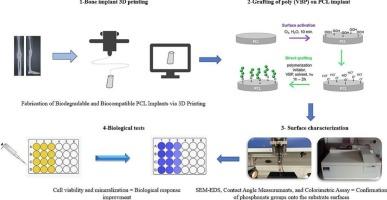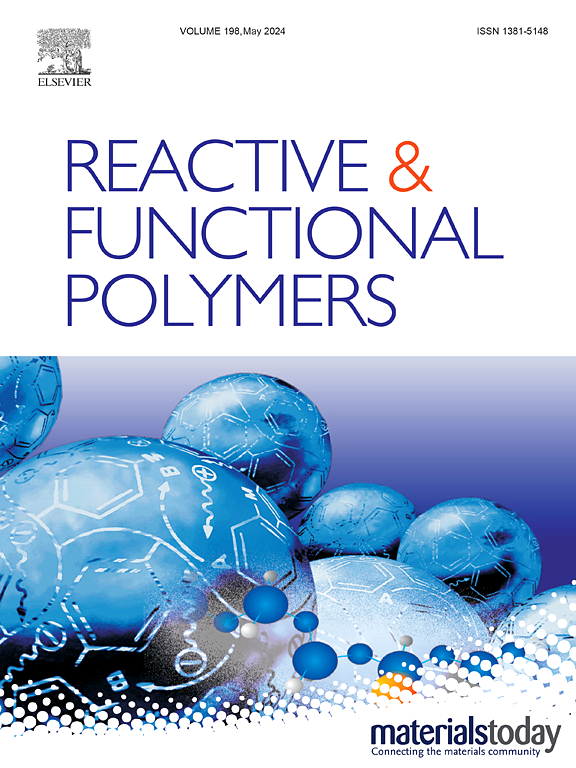在 3D 打印聚己内酯支架上接枝膦酰化聚合物可提高成骨细胞增殖和体外钙矿化率
IF 5.1
3区 工程技术
Q1 CHEMISTRY, APPLIED
引用次数: 0
摘要
假体植入或骨移植目前用于治疗骨质疏松症、骨肿瘤或骨折引起的骨缺损。然而,这些传统的外科技术可能会导致严重的并发症,包括感染、松动和排斥反应。因此,可能需要进行额外的手术,甚至截肢。在这种情况下,推进骨修复策略的发展仍然是一项严峻的挑战。本初步研究概述了一种开发可生物降解且具有生物活性的 PCL 植入物的方法,这种植入物可改善成骨细胞对骨再生的生物反应。为了完善和优化接枝条件,对臭氧时间、紫外辐照持续时间和反应介质等关键参数进行了调整。接枝过程的成功与否采用了多种表征技术进行评估,包括比色法、接触角测量、扫描电子显微镜(SEM)、能量色散 X 射线光谱(EDS)、衰减全反射-傅立叶变换红外光谱(ATR-FTIR)、差示扫描量热法(DSC)和尺寸排阻色谱法(SEC)。此外,还利用小鼠前成骨细胞(MC3T3-E1 细胞系)对细胞反应进行了研究,重点是细胞活力、形态和矿化。研究结果表明,在植入物表面接枝含有膦酸盐基团的生物活性聚合物会产生有益的影响。本文章由计算机程序翻译,如有差异,请以英文原文为准。

Grafting of phosphonylated polymers onto 3D printed polycaprolactone scaffolds improves osteoblasts proliferation and calcium mineralization in-vitro
Prosthesis implantation or bone grafting are currently used to treat bone defects induced by osteoporosis, bone tumors or fractures. However, these conventional surgical techniques can lead to significant complications, including infection, loosening, and rejection. Consequently, additional surgeries or even amputation of the affected limb may become necessary. In this context, advancing the strategies used for bone repair remains a critical challenge. The present preliminary study outlines a method for developing biodegradable and bioactive PCL implants with improved osteoblast biological response for bone regeneration., vinylbenzylphosphonic acid (VBP) monomer was grafted and polymerized onto the 3D printed cylindrical polycaprolactone (PCL) implants using a two-step UV irradiation process. To refine and optimize the grafting conditions, key parameters such as ozonation time, UV irradiation duration, and reaction medium were adjusted. The success of the grafting process was assessed using various characterization techniques, including colorimetry, contact angle measurements, scanning electron microscopy (SEM), energy-dispersive X-ray spectroscopy (EDS), Attenuated Total Reflection-Fourrier Transform Infrared Spectroscopy (ATR-FTIR), differential scanning calorimetry (DSC), and size-exclusion chromatography (SEC). Furthermore, a study of the cellular response focusing on viability, morphology, and mineralization was conducted using mouse preosteoblasts (MC3T3-E1 cell line). The results demonstrated the beneficial effects of grafting a bioactive polymer containing a phosphonate group onto implant surfaces.
求助全文
通过发布文献求助,成功后即可免费获取论文全文。
去求助
来源期刊

Reactive & Functional Polymers
工程技术-高分子科学
CiteScore
8.90
自引率
5.90%
发文量
259
审稿时长
27 days
期刊介绍:
Reactive & Functional Polymers provides a forum to disseminate original ideas, concepts and developments in the science and technology of polymers with functional groups, which impart specific chemical reactivity or physical, chemical, structural, biological, and pharmacological functionality. The scope covers organic polymers, acting for instance as reagents, catalysts, templates, ion-exchangers, selective sorbents, chelating or antimicrobial agents, drug carriers, sensors, membranes, and hydrogels. This also includes reactive cross-linkable prepolymers and high-performance thermosetting polymers, natural or degradable polymers, conducting polymers, and porous polymers.
Original research articles must contain thorough molecular and material characterization data on synthesis of the above polymers in combination with their applications. Applications include but are not limited to catalysis, water or effluent treatment, separations and recovery, electronics and information storage, energy conversion, encapsulation, or adhesion.
 求助内容:
求助内容: 应助结果提醒方式:
应助结果提醒方式:


